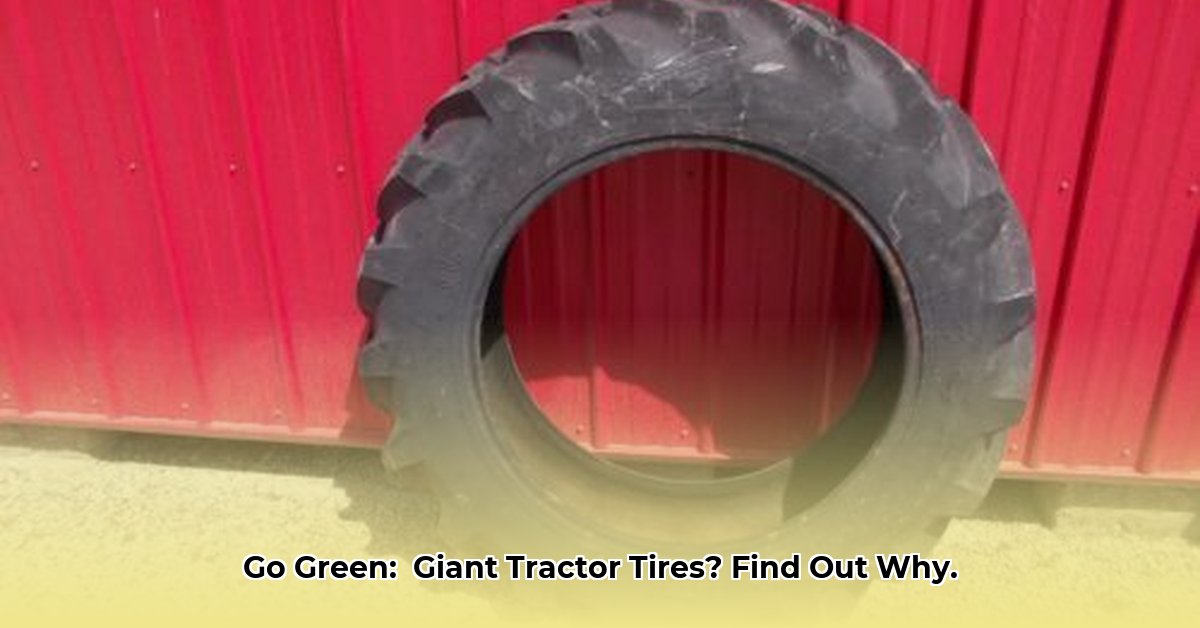
Large 16.9x28 tractor tires are essential for farming, but their lifecycle significantly impacts the environment. This guide explores sustainable practices for farmers, manufacturers, and policymakers to minimize this impact. For more information on tractor tires, check out this resource.
The Lifecycle of a 16.9x28 Tractor Tire: From Creation to Disposal
The journey of a 16.9x28 tractor tire begins with raw material extraction and manufacturing, processes that consume considerable energy and resources. The tire then endures years of field work, gradually wearing down and potentially contributing to soil erosion. Finally, it becomes waste, often ending up in landfills. This entire process generates a substantial environmental footprint. Isn't it time we considered more sustainable choices?
Sustainable Solutions: Minimizing the Environmental Impact
Fortunately, numerous innovative solutions are emerging to reduce the environmental burden associated with these essential agricultural components.
Extending Tire Lifespan: Investing in Longevity
Creating durable tires that last longer reduces the need for replacements, thus minimizing manufacturing, transportation, and waste. Proper inflation and regular maintenance are paramount for maximizing tire lifespan. Think of it as preventative maintenance – a small investment for significant long-term savings.
Recycling Rubber: A Circular Economy Approach
Utilizing recycled rubber in tire manufacturing significantly reduces reliance on virgin materials, supporting a circular economy model. This approach conserves natural resources and minimizes waste.
Bio-based Rubber: Exploring Sustainable Alternatives
Scientists are exploring bio-based materials, such as guayule rubber, as potential alternatives to traditional rubber. While research is ongoing to fully assess long-term environmental and economic impacts, initial results suggest considerable potential for reducing carbon emissions.
Tire Recycling Programs: Responsible Waste Management
Effective tire recycling programs are vital. These programs recover valuable materials from discarded tires, diverting them from landfills and reducing environmental harm. It's worth investigating available programs in your area and advocating for enhanced infrastructure where needed.
Actionable Steps for a Greener Future
Here are practical steps for various stakeholders to adopt sustainable practices:
For Farmers: Implementing Sustainable Practices
Implement Tire Pressure Monitoring Systems (TPMS): Regularly monitoring and maintaining optimal tire pressure maximizes fuel efficiency and extends tire lifespan (reducing waste and saving money). Research shows that proper inflation can increase tire life by up to 20%.
Prioritize Regular Tire Maintenance: Routine inspections and timely repairs prevent premature wear, prolonging tire life and minimizing waste. This preventative approach mirrors routine vehicle maintenance—a small investment for significant long-term returns.
Make Informed Purchasing Decisions: Research and select tires produced with recycled materials or from manufacturers committed to environmental sustainability. Consider the total cost of ownership, encompassing both initial purchase price and long-term environmental and operational costs.
For Tire Manufacturers: Leading the Way in Sustainability
Invest in R&D for Sustainable Materials and Processes: Increased investment in research and development is crucial for discovering and implementing eco-friendly materials and manufacturing processes. This fosters innovation and enhances the industry’s long-term competitiveness.
Develop Comprehensive Closed-Loop Recycling Programs: Creating effective recycling programs, focusing on maximum material recovery and reuse, is essential for a truly sustainable industry.
Prioritize Transparency: Openly communicating the environmental impact of products establishes trust with consumers and promotes responsible purchasing decisions. Clear, accessible information on environmental performance is key.
For Policymakers and NGOs: Shaping Sustainable Policies
Offer Financial Incentives: Governments and NGOs can provide grants, tax breaks, and other financial incentives to encourage farmers and manufacturers to adopt sustainable practices. This promotes wider adoption of environmentally friendly approaches.
Invest in Recycling Infrastructure: Adequate investment in recycling infrastructure is essential for efficient and effective tire recycling, ensuring proper waste management and resource recovery.
Create Clear and Enforceable Regulations: Establishing comprehensive regulations regarding tire disposal and manufacturing practices establishes environmental protection and ensures certainty for all stakeholders.
Weighing the Costs and Benefits: A Long-Term Perspective
While sustainable 16.9x28 tractor tires may have a slightly higher initial cost, the long-term benefits—extended lifespan, fuel savings, and reduced environmental impact—outweigh the upfront investment. The cumulative savings on fuel and replacement tires often offset the higher initial price tag.
Conclusion: A Collaborative Approach to Sustainable Agriculture
The future of sustainable agriculture depends upon collaborative efforts among farmers, manufacturers, policymakers, and researchers. By working together, we can ensure farming practices don't compromise the environment. Let's continue this vital conversation and explore further innovative solutions.
How to Choose Sustainable Agricultural Tires: A Detailed Guide
Choosing the right tires is a crucial decision impacting both cost and environmental impact. This section delves into factors influencing the choice between radial and bias-ply tires and outlines broader sustainable tire practices.
Radial vs. Bias-Ply Tires: A Comparative Analysis
Radial tires generally offer superior fuel efficiency and traction, leading to reduced soil compaction and emissions. However, they usually come with a higher initial cost. Bias-ply tires are less expensive but often result in greater fuel consumption and a shorter lifespan. The best choice depends on various factors.
Factors to Consider
- Budget: Consider the initial investment (radial tires are typically more expensive), long-term fuel savings, and reduced replacement costs.
- Soil Type: Radial tires generally excel on heavy clay soils, while bias-ply tires may be suitable for sandy or loose soils.
- Farming Practices: No-till farming benefits greatly from radial tires' reduced compaction, while intensive tillage may favor the durability of bias-ply tires.
- Tire Maintenance: Regular inflation checks and maintenance are essential regardless of tire type to maximize lifespan and avoid premature wear.
Sustainable Tire Practices
- Tire Rotation: Rotate tires regularly to ensure even wear.
- Proper Inflation: Consistent and proper tire inflation is a cornerstone of maximizing tire life and reducing fuel consumption.
- Recycling: Explore end-of-life tire recycling options.
- Sustainable Materials: Inquire about tires made with recycled or renewable materials, but carefully evaluate trade-offs.
- Reduced Soil Compaction: Utilize conservation tillage to mitigate soil compaction and increase tire lifespan.
Making the Optimal Choice
Choosing sustainable agricultural tires requires a comprehensive cost-benefit analysis, balancing initial investment with long-term fuel efficiency, tire lifespan, and environmental impact. Careful consideration of the above factors is crucial for making informed decisions.